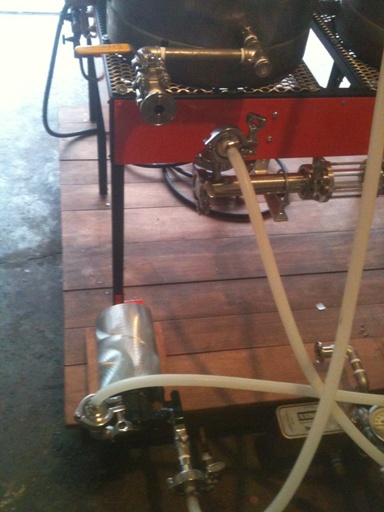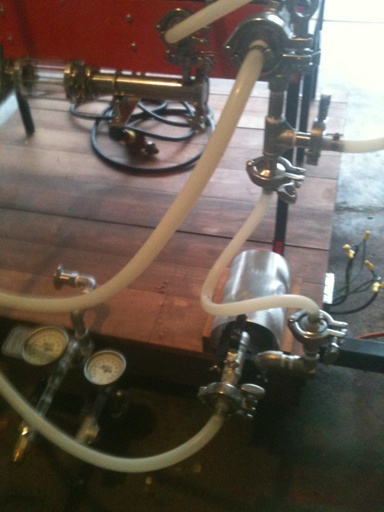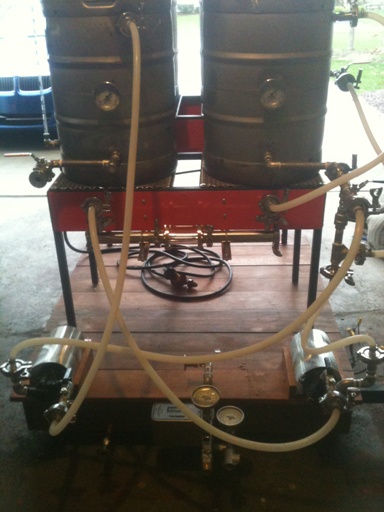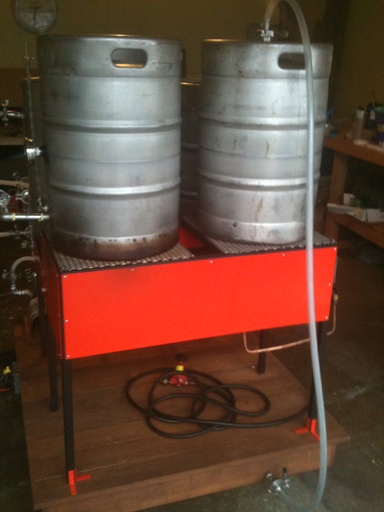pola0502ds
Well-Known Member
- Joined
- Jan 12, 2011
- Messages
- 846
- Reaction score
- 3
outlet pointing up.
That stinks. on both of my pumps I have the inlets pointing up and the outlets horizontal. Will I run into problems?

outlet pointing up.
Yeah as i said it is a bit vague, 30% sodium metasilicate / 70% others.
Do you know exactly what is in it?
As far as priming the pumps go, basic rule is this: Keep the pump below the liquid level and when you open the supply valve the fluid should flood the pump naturally with just gravity. The discharge of the pump should be at the highest point of the pump if possible. If you have the pump mounted horizontally, then the inlet will be on your left and outlet will be on your right when you are facing the pump. If mounted vertically then the outlet pointing to the ceiling is the best way.
Walter can you please provide some clarification here? By "horizontal", do you mean the drive shaft is horizontal? I have in-line 809's with stainless "Chugger" heads, the drive shaft is horizontal (parallel to the ground) and the inlet faces the floor and the outlet faces the ceiling.
Thats the ideal setup as far as orrientation of the pump goes. If you cant get the outlet to face the cieling then you would need to have the outlet facing to the right when looking at the pump head face on.
I occasionally have troubles with priming, even when I open the valve on my kettles and the outlet of the pump, and let liquid flow down to the pump head before turning the pump on.
unless you are trying to transfer a wort in a state of rolling boing where you may get air sucked intot he pump when its spinning then the only other issue i can think of that may cause problems would be if you had a trap (Or low point) on the discharge side of the pump that can collect some liquid and not not let air pass through.
Thanks again for catering to us homebrewers! Plus, hey, it gives you an excuse to read HBT at work. Side question though, do you brew? If not, how long do you think you can resist until you get the itch? Hahaha...
"Originally Posted by Mike_A
Walter can you please provide some clarification here? By "horizontal", do you mean the drive shaft is horizontal? I have in-line 809's with stainless "Chugger" heads, the drive shaft is horizontal (parallel to the ground) and the inlet faces the floor and the outlet faces the ceiling.
Thats the ideal setup as far as orrientation of the pump goes. If you cant get the outlet to face the cieling then you would need to have the outlet facing to the right when looking at the pump head face on."
Wow,
on both my pumps I have the inlet facing the ceiling and i have the outlet horizontal face you if you are looking directly at it. I tested both of them for the first time this weekend and it worked fine.
Question from everyone. I noticed a lot of air bubbles running through my lines while I was testing. The fittings connected to the keg were completely filled with water such as everything else, where the hell is this air coming from? Maybe my hose is not clamped to the hose barb tight enough? They are pretty tight right now as is. It seems like when I have air bubbles I will grab the hose to remove the tension that the hose has on the hose barb from it's own weight with water in it and the air bubbles go away. As soon as i stop holding the hose, the air bubbles come back.

I do not have the center outlet design. For the march pump the inlet and outlet on the pump cover are horizontal with one on each side. For the pump I bought from sabco both inlet and outlets are on the right side pointing up at a 45 degree angle. I dont like this pump as much but it does not produce anywhere near as much noise as the march pump. I used some elbows and other fittings to do what I did.
I think it's the hose bending and kinking because once I pick up the hose with my hand and move it a certain way the bubbles go away.
How can something like that cause air bubbles when there's no air in the lines to begin with?
What does cavitating the pump mean?
here is a pic of my pumps.
Mike_A said:If you're going to restrict the outlet side of the March pump (presumably with a valve), do it immediately at the outlet, OR use something stronger than silicone tubing between the pump outlet and the valve.
"Head" refers to the VERTICAL column (of water, in this case) that the pump is capable of pumping. i.e. if the outlet pointed straight up and you had a rigid tube pointing straight up, the pump could pump as high as X feet of head (if pumping water). Denser substances, bends in the tube, restrictions, the surface finish of the walls of the tube/pipe all play a factor in limiting the head of the pump. The conditions that March will provide are all under ideal circumstances. You can basically count on getting significantly less head than the spec sheet says because of all those factors (and many more!) that exist in your system.
Introduction to centrifugal pumps
As per the article in the link, head refers to the height the pump can move the liquid above it.
In the system you describe, the ball valve should be at the fermenter. You want the restriction to be at the end of the flow path, if possible.
You do not want anything to interfere with the flow rate into the pump. In the case of using a hop back, you want a valve before the the hopback and one before the fermenter so you can control the flow rates both into and out of the hopback.
Here are some quotes from the March pump installation manual
When using an elbow, valve, etc., the suction must have straight piping in length at least five (5) times the diameter of the pipe.[/SIZE][/I][/B]
According to the instruction manual, you should have at least 2.5" (preferably longer) straight pipe directly before the suction inlet.
How many builds have you seen that did not follow any of the above March pump installation instructions then blamed the pump as the problem?
Am I allowed to say all of them?

Here are some quotes from the March pump installation manual
Install the pump as near to the suction source and as low as possible. Suction must be flooded. When using an
elbow, valve, etc., the suction must have straight piping in length at least five (5) times the diameter of the pipe.
All suction piping should be direct and short as possible with as little bending as possible. Excessive bending and
pump suction length will lead to flow distortion and pump cavitation.
You have elbows directly connected to the suction inlet. According to the instruction manual, you should have at least 2.5" (preferably longer) straight pipe directly before the suction inlet.
You also have a very long run of hose with lots of bends that can cause restriction and collapse of the walls of the hose.
A suggestion would be to move your pumps closer to the vessels and try to configure your piping to minimize the length of the hose to the inlet. Try to remove elbows from the suction side. Make sure ALL connections to the inlet side are 1/2" ID minimum.
I originally had my pumps set up similar to yours. I recently removed the elbows from both inlet and outlet and changed my pipe thread to hose barbs to a full 1/2" ID. This resulted in much improved flow through put. I do not have any problem with cavitation, bubbles or getting the pump to prime.
I keep hearing everyone say that bends restrict the flow. As i am someone new to this, I cant wrap my finger around it. I just don't understand why it would cause any problems as liquid can take any shape, if that makes sense.
I agree, we need a sticky.
Last night i was playing around with my system. I have 2 kettles that sit next to each other on the same level. Both were about half way full and i needed to transfer water from one into the other. I had a huge problem doing this, the pump wouldn't prime or transfer any of the water and I think it's because both were on the same level, same amount of water in each to begin with, and head pressure. Am I correct?
I have a 809 and love it. But I'm working on going pro and I was wondering what other pumps you have that are heat rated for over 212* and higher flow rates.
Interesting info here.. so I know alot of us have a similar setup with 1/2" silicone hoses and the camlocks with the street 90 elbow. From the sound of what Wayne is stating, that's less than ideal and I should have a different hose that I use for the inlet side of the pump that doesn't have the street 90 on it as that 90 is causing a restriction on the inlet side and could lead to cavitation (I have the HF pump and it seems to work well, but just curious if I could get improved performance by changing my setup)
Im looking for a triclover head on a 809, were can i get one?
Im looking for a triclover head on a 809, were can i get one?




Walter:
Do you have a local distributor in Columbus, Ohio or should I order my next pump online again. I would really like to buy local if possible.
Thank you,
Kevin
Guys, now that I am doing more tested I am really running into problems with the pump not priming. Can you guys look at my pictures in this thread and critique my build? I would also like it if someone can provide info on how to add a priming fixture/valve assemble to each pump. Maybe some threads that exist?
Just so you know the front left keg is my BK, the front right is my mash tun, the back right is my HLT, and the back left is my keg to create steam which will be used to sanitize my therminator, run through the lines to clean, and to prep my fermenter. The keg that creates steam is what I will be fermenting in. Kill 2 birds with one stone.
Enter your email address to join: